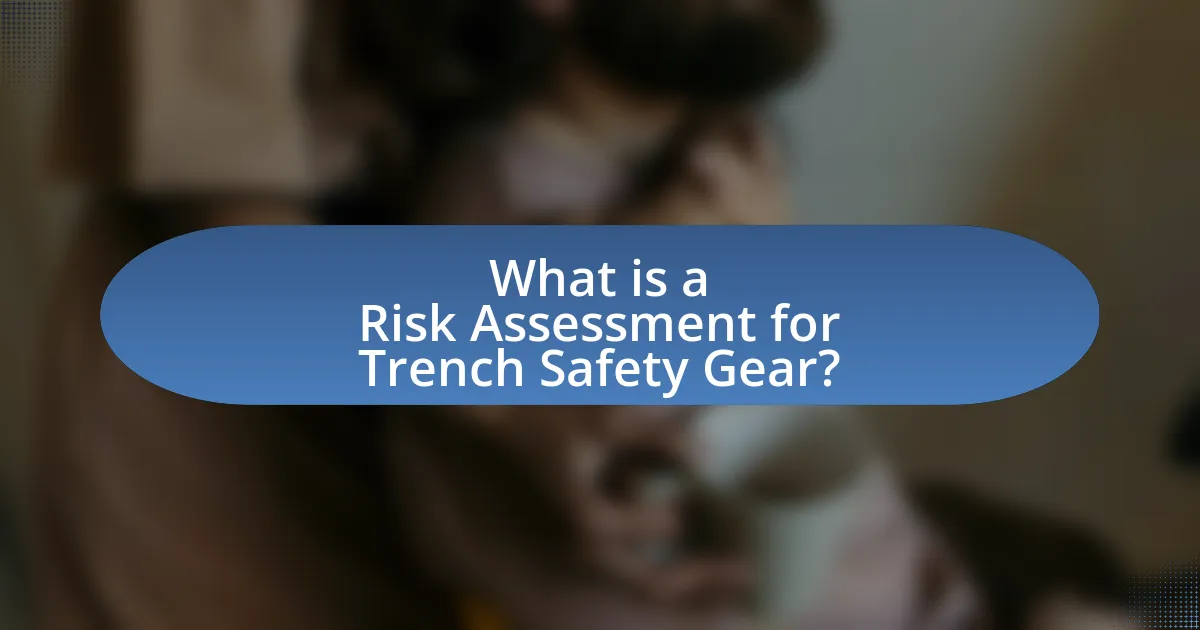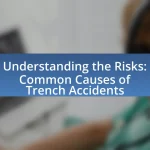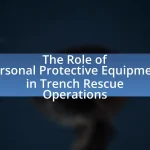A risk assessment for trench safety gear is a systematic evaluation process aimed at identifying potential hazards associated with trench work and assessing the effectiveness of safety equipment in mitigating these risks. Key components of this assessment include hazard identification, risk evaluation, control measures, and monitoring procedures, all of which are essential for ensuring worker safety and compliance with Occupational Safety and Health Administration (OSHA) regulations. The article outlines the importance of conducting thorough risk assessments to prevent accidents, the types of safety gear that should be evaluated, and the environmental factors that influence the assessment process. Additionally, it discusses best practices for conducting assessments, the role of training, and strategies to enhance the accuracy and effectiveness of risk evaluations in trench safety operations.

What is a Risk Assessment for Trench Safety Gear?
A risk assessment for trench safety gear is a systematic process that identifies potential hazards associated with trench work and evaluates the effectiveness of safety equipment in mitigating those risks. This assessment involves analyzing factors such as soil conditions, trench depth, and the presence of underground utilities, which can impact the safety of workers. According to the Occupational Safety and Health Administration (OSHA), proper risk assessments are crucial for preventing accidents and ensuring compliance with safety regulations in trenching operations.
Why is conducting a risk assessment important for trench safety gear?
Conducting a risk assessment is crucial for trench safety gear because it identifies potential hazards and evaluates the risks associated with trench work. This proactive approach ensures that appropriate safety measures are implemented, reducing the likelihood of accidents and injuries. According to the Occupational Safety and Health Administration (OSHA), trenching and excavation work poses significant risks, with cave-ins being one of the leading causes of fatalities in the construction industry. By systematically assessing risks, employers can select suitable safety gear, such as shoring systems and personal protective equipment, tailored to the specific conditions of the trench site, thereby enhancing worker safety and compliance with regulatory standards.
What are the potential hazards associated with trench work?
The potential hazards associated with trench work include cave-ins, falls, hazardous atmospheres, and equipment-related incidents. Cave-ins are the leading cause of fatalities in trenching, with the Occupational Safety and Health Administration (OSHA) reporting that they account for 75% of trench-related deaths. Falls can occur when workers are near the edge of the trench, and hazardous atmospheres may arise from the presence of toxic gases or insufficient oxygen levels. Additionally, equipment-related incidents can happen when machinery is operated too close to the trench, posing risks to workers. These hazards necessitate stringent safety measures and risk assessments to ensure worker safety in trench environments.
How can risk assessments prevent accidents in trench operations?
Risk assessments can prevent accidents in trench operations by identifying potential hazards and implementing control measures before work begins. By systematically evaluating risks such as cave-ins, falling objects, and hazardous atmospheres, safety personnel can develop strategies to mitigate these dangers. For instance, the Occupational Safety and Health Administration (OSHA) emphasizes that proper risk assessments lead to the use of protective systems like trench boxes and shoring, which significantly reduce the likelihood of accidents. Historical data shows that trenches without adequate safety measures have a higher incidence of fatalities, underscoring the importance of thorough risk assessments in enhancing worker safety.
What are the key components of a trench safety gear risk assessment?
The key components of a trench safety gear risk assessment include hazard identification, risk evaluation, control measures, and monitoring procedures. Hazard identification involves recognizing potential dangers such as cave-ins, falling loads, and hazardous atmospheres. Risk evaluation assesses the likelihood and severity of these hazards, determining the level of risk associated with each. Control measures are strategies implemented to mitigate identified risks, which may include the use of protective equipment, proper trench design, and safety training. Finally, monitoring procedures ensure ongoing compliance with safety standards and the effectiveness of implemented controls, allowing for adjustments as necessary. These components are essential for ensuring worker safety in trenching operations, as supported by OSHA guidelines and industry best practices.
What types of trench safety gear should be evaluated?
The types of trench safety gear that should be evaluated include trench boxes, shoring systems, personal protective equipment (PPE), and warning systems. Trench boxes provide a protective barrier against soil collapse, while shoring systems support trench walls to prevent cave-ins. PPE, such as hard hats, gloves, and steel-toed boots, protects workers from potential hazards. Warning systems, including alarms and signage, alert workers to dangers associated with trench work. Evaluating these types of gear is essential for ensuring worker safety and compliance with OSHA regulations, which mandate protective measures in trenching operations to minimize risks of accidents and injuries.
How do environmental factors influence the risk assessment process?
Environmental factors significantly influence the risk assessment process by affecting the likelihood and severity of potential hazards. For instance, soil type, moisture levels, and weather conditions can alter the stability of trenches, impacting the risk of collapses. Research indicates that wet soil increases the risk of trench failure by up to 50%, highlighting the importance of assessing environmental conditions during risk evaluations. Additionally, temperature extremes can affect the performance of safety gear, necessitating adjustments in risk assessments to ensure worker safety. Thus, understanding these environmental factors is crucial for accurate risk assessments in trench safety.
What steps are involved in conducting a risk assessment for trench safety gear?
The steps involved in conducting a risk assessment for trench safety gear include identifying hazards, assessing risks, implementing control measures, and reviewing the assessment. First, identifying hazards involves recognizing potential dangers such as cave-ins, falling objects, and hazardous atmospheres. Next, assessing risks requires evaluating the likelihood and severity of incidents related to these hazards. Implementing control measures involves selecting appropriate safety gear and procedures to mitigate identified risks, such as using trench boxes or shoring systems. Finally, reviewing the assessment ensures that the risk management strategies remain effective and are updated as necessary, based on changes in conditions or regulations.
How do you identify hazards in trench work?
To identify hazards in trench work, conduct a thorough site assessment that includes evaluating soil conditions, checking for underground utilities, and assessing the stability of trench walls. Soil type influences the risk of collapse; for instance, loose or wet soil increases hazard levels. Additionally, identifying nearby traffic or heavy equipment can help assess risks related to falling objects. According to OSHA regulations, a competent person must inspect trenches daily and after any change in conditions to ensure safety. This systematic approach ensures that potential hazards are recognized and mitigated effectively.
What methods can be used to assess the level of risk?
Methods to assess the level of risk include qualitative assessments, quantitative assessments, and expert judgment. Qualitative assessments involve identifying potential hazards and evaluating their impact through techniques like brainstorming and checklists. Quantitative assessments utilize statistical methods to analyze data, such as calculating the probability of occurrence and potential losses, often employing tools like risk matrices. Expert judgment relies on the insights of experienced professionals to evaluate risks based on their knowledge and past experiences. These methods are validated by their widespread use in safety protocols and risk management frameworks, ensuring a comprehensive understanding of potential risks in trench safety gear assessments.
How do you implement control measures based on the assessment?
To implement control measures based on the assessment, first identify the specific risks associated with trench safety gear, such as potential cave-ins or equipment failure. Next, develop targeted strategies to mitigate these risks, which may include providing proper training for workers, utilizing protective equipment like trench boxes, and ensuring regular inspections of safety gear. Evidence from the Occupational Safety and Health Administration (OSHA) indicates that effective training and equipment use can significantly reduce accidents in trenching operations, highlighting the importance of these control measures in enhancing safety.
How can you ensure compliance with safety regulations during the assessment?
To ensure compliance with safety regulations during the assessment, conduct a thorough review of applicable local, state, and federal safety standards relevant to trench safety gear. This involves familiarizing yourself with regulations such as OSHA standards, which mandate specific safety measures for trenching operations, including protective systems and training requirements. Additionally, maintaining accurate documentation of safety protocols and assessment findings reinforces compliance, as it provides a clear record of adherence to regulations. Regular training sessions for personnel on these regulations further ensure that all team members are aware of and understand the safety requirements, thereby minimizing risks associated with trench safety.
What regulations govern trench safety gear usage?
The regulations that govern trench safety gear usage are primarily outlined by the Occupational Safety and Health Administration (OSHA) under 29 CFR Part 1926, specifically in Subpart P, which addresses excavation and trenching. These regulations mandate that employers provide appropriate personal protective equipment (PPE) to workers in trenching operations, including hard hats, safety glasses, and high-visibility clothing, to mitigate risks associated with cave-ins and other hazards. OSHA’s standards require that trenches deeper than five feet be protected against collapse, and the use of safety gear is a critical component of this protection strategy. Compliance with these regulations is essential for ensuring worker safety and preventing accidents in trenching activities.
How do you document the risk assessment process for compliance?
To document the risk assessment process for compliance, organizations should create a structured report that outlines identified hazards, risk levels, and mitigation strategies. This report typically includes sections such as the scope of the assessment, methodology used, findings, and recommendations for compliance with relevant safety regulations. For instance, according to OSHA guidelines, documenting risk assessments helps ensure that safety measures are in place and that organizations can demonstrate compliance during inspections.
What are common challenges faced during risk assessments for trench safety gear?
Common challenges faced during risk assessments for trench safety gear include identifying potential hazards, ensuring compliance with regulations, and evaluating the effectiveness of safety measures. Identifying hazards can be difficult due to the dynamic nature of trench environments, where conditions can change rapidly. Compliance with regulations, such as those set by OSHA, requires thorough knowledge and understanding of safety standards, which can be complex. Evaluating the effectiveness of safety measures often involves subjective assessments and may lack concrete data, making it challenging to determine if the gear adequately protects workers.
How can you overcome resistance to safety measures in the workplace?
To overcome resistance to safety measures in the workplace, engage employees through education and communication about the importance of safety protocols. Research shows that when employees understand the rationale behind safety measures, compliance increases; for instance, a study by the National Safety Council found that effective training can reduce workplace injuries by up to 30%. Additionally, involving employees in the development and implementation of safety measures fosters a sense of ownership and accountability, further reducing resistance.
What strategies can be employed to improve assessment accuracy?
To improve assessment accuracy in trench safety gear risk assessments, employing standardized evaluation criteria is essential. Standardized criteria ensure consistency in evaluating risks associated with trench safety gear, allowing for reliable comparisons and informed decision-making. Research indicates that using a systematic approach, such as the Hierarchy of Controls, enhances the identification of hazards and the effectiveness of safety measures. Additionally, incorporating feedback from field personnel who use the gear can provide practical insights that refine assessment processes. A study published in the Journal of Safety Research found that assessments incorporating user feedback improved risk identification by 30%, demonstrating the value of practical experience in enhancing accuracy.
What best practices should be followed when conducting a risk assessment for trench safety gear?
When conducting a risk assessment for trench safety gear, best practices include identifying potential hazards, evaluating the risks associated with those hazards, and implementing control measures to mitigate identified risks. Identifying hazards involves assessing factors such as soil type, trench depth, and environmental conditions, which can influence the stability of the trench and the safety of workers. Evaluating risks requires analyzing the likelihood of incidents occurring and the potential severity of injuries, which can be informed by historical data on trench-related accidents. Implementing control measures may involve using appropriate safety gear, such as helmets, harnesses, and shoring systems, to protect workers. According to the Occupational Safety and Health Administration (OSHA), proper risk assessments can significantly reduce the incidence of trench-related injuries and fatalities, emphasizing the importance of following these best practices.
How often should risk assessments be reviewed and updated?
Risk assessments should be reviewed and updated at least annually or whenever there are significant changes in operations, regulations, or after an incident. Regular reviews ensure that the risk assessment remains relevant and effective in identifying potential hazards associated with trench safety gear. According to the Occupational Safety and Health Administration (OSHA), frequent updates are essential to adapt to evolving safety standards and practices, thereby minimizing risks in the workplace.
What role does training play in effective risk assessments?
Training is essential for effective risk assessments as it equips individuals with the necessary skills and knowledge to identify, evaluate, and mitigate risks accurately. Proper training ensures that personnel understand safety protocols, recognize potential hazards, and apply risk assessment methodologies effectively. For instance, studies show that organizations with trained staff experience a 30% reduction in workplace accidents, highlighting the direct correlation between training and improved risk management outcomes.
What practical tips can enhance the effectiveness of trench safety gear risk assessments?
To enhance the effectiveness of trench safety gear risk assessments, implement a systematic approach that includes thorough inspections, employee training, and regular updates to safety protocols. Conducting detailed inspections of trench safety gear ensures that all equipment meets current safety standards and is free from defects. Training employees on the proper use and limitations of safety gear increases awareness and compliance, reducing the likelihood of accidents. Additionally, regularly updating safety protocols based on new regulations or incident reports ensures that assessments remain relevant and effective. These practices are supported by data indicating that organizations with comprehensive safety training and regular equipment checks experience significantly fewer workplace injuries, as reported by the Occupational Safety and Health Administration (OSHA).


